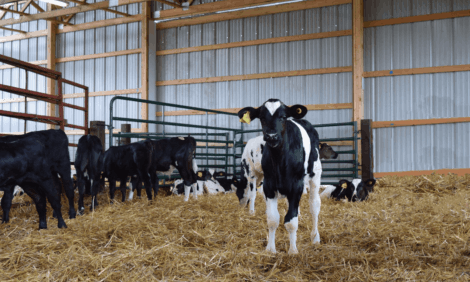



How Big A Problem Is Dairy Cow Mortality In The US?
Franlyn Garry from Colorado State University, has said that the frequency of adult dairy cow mortality appears to be increasing, and is related to culling, disease, and injury problems. Mortality rates in the dairy industry are much higher than those in the cow/calf or feedlot industries. Death losses have not been studied very intensively in the dairy industry. Estimates of these death losses are quite variable. Unless they are focused on monitoring cow deaths, dairy producers may underestimate the amount of adult cow death loss on their operations. The USDA:APHIS:VS National Animal Health Monitoring System (NAHMS) Dairy 2007 survey reported that 5.7 per cent of dairy cows die on-farm across the country each year, an increase from 4.8 per cent of the January 2002 inventory and 3.8 per cent of the January 1996 inventory. These rising mortality levels represent a problem both in terms of financial losses and compromised animal welfare.
Information from computerized dairy record systems suggests that mortality rates have continually increased over the last 10 years. In some states, adult cow mortality exceeds 10 per cent per year. Very few formal studies have focused on this issue, yet dairy cattle death losses are an extremely important problem. Not only are these losses an economic disaster, they also represent very substantial problems with animal well-being. This would seem to be an issue requiring substantial veterinary attention, but at present it does not appear that veterinarians or producers have the information required to manage the problem appropriately.
Why do dairy cows die?
Most studies of dairy cow mortality have come from outside the United States. The US studies on this issue have been primarily focused on culling and herd turnover rates rather than death losses per se. The 2007 national survey of dairies in the US showed that approximately 23.6 per cent of dairy cows left herds permanently during 2007, and that approximately 5.5 per cent of these cows were sold to other dairies, while 94 per cent were culled (i.e., sold and not returned to milk production, sent for slaughter).
The reasons cows were culled included reproductive failure (26.3 per cent of culled cows), mastitis and udder problems (23 per cent), lameness or injury (16 per cent), other disease (3.7 per cent), and poor milk production not related to these other problems (16 per cent), while other miscellaneous reasons accounted for about 8 per cent of culling. Therefore, on average, the overwhelming majority of dairy cows leaving farms are not fit for sale as dairy production animals, and approximately 50 per cent of these cows leave because of disease or injury problems rather than being selectively removed because of low fertility or milk productivity.
Adult cow death losses appear to be attributable to reasons similar to those for culling cows. A recent literature review identified 19 studies between the years 1965 and 2006 that focused on dairy cow mortality in countries with relatively intensive dairy production. While 10 of the 19 studies provided information about causes of death, none of the diagnoses were founded on necropsy evaluation.
Only a single study discriminated between cows that were euthanized or died unassisted. Recorded causes of death were relatively uniform across studies and were categorized as: accidents, calving disorders, digestive disorders, locomotor disorders, metabolic disorders, udder/teat disorders, other known reasons, and unknown reasons. The NAHMS Dairy 2007 survey recorded causes of death similarly to those established through the literature review, documenting the percentage of cow deaths due to: euthanasia due to lameness or injury (20.0 per cent); mastitis (16.5 per cent); calving problems (15.2 per cent); respiratory problems (11.3 per cent); scours, diarrhea, or other digestive problems (10.4 per cent); lack of coordination or severe depression (1.0 per cent); poison (0.4 per cent); other known reasons (10.2 per cent); and unknown reasons (15.0 per cent).
Cause of death entered in dairy record systems is often based on producer assessment and diagnosis. It appears that dairy veterinarians are minimally involved in the diagnosis of cause of death, and relatively few US dairy operations perform necropsies in an effort to determine the cause of cow death. The NAHMS Dairy 2007 study reported that necropsies were performed on only 13 per cent of operations and only 4.4 per cent of cow deaths received a thorough postmortem examination. Therefore, to date, virtually all studies of dairy cow mortality are based on producer assessment rather than veterinary diagnosis. Determining the cause of death provides invaluable information for preventing future deaths and improving herd health.
At present, no specific reason has been identified for the increase in dairy cow death rates. Producers and veterinarians appear to have attributed increasing death rates to a variety of causes. Some have questioned whether the new federal regulations regarding down dairy cows and neurologic disease may have artificially increased recorded death rates.
While this will contribute to recorded mortalities, death rates were increasing prior to the implementation of this rule. Furthermore, if euthanized down cows represent more than a small fraction of dairy mortalities, we need to ask why so many cows need to be euthanized. Others have suggested that specific disease problems such as hemorrhagic bowel disease may be increasing death rates, but the increased mortality rates far exceed the incidence of any specific disease problem. Any conjectures on the cause of increased mortality are difficult to validate without specific diagnoses.
Dairy record systems appear to be an unreliable source of information concerning cause of death. We have been studying the phenomenon of dairy cow mortality over the last couple of years. Our findings suggest that dairy producer assessment of the proximate cause of death is inaccurate approximately 50 per cent of the time. Our results also show that there are multiple causes of dairy cow death. Mortalities tend to occur much more frequently in the early part of lactation, coincident with increases in other health problems. Increased disease rates on dairies appear to be closely related to increased death rates. It seems reasonable to suggest that numerous health problems in dairy cows are not recognized early enough or not treated properly to promote an optimal outcome. Furthermore, without good descriptors and records of the reasons that cows die, preventive measures that should decrease disease and death are not modified or improved to address the problem.
What can be done to decrease dairy cow deaths?
Most decisions in a low-cost production dairy model are made with input cost as the primary driving force, and potential negative impacts on the animals in the production system are seen as problems that must be managed as a consequence. For example, it is common that large-scale expansion of a dairy will capture production cost efficiencies but often with the caveat that expansions are accompanied by substantial problems with animal health. During the time that large numbers of animals are being imported to the herd, it is routine that disease introduction is occurring. Numerous animal health problems are prevalent and even increase with time. Because there are compelling reasons for dairies to expand, there is a real need for the dairy industry and dairy veterinarians to reevaluate dairy management systems with a focus on optimum animal health.
An overview of the health challenges faced by dairy cows needs to recognize that some changes in the modern dairy industry may result in systematic problems with animal care. The labor force on most dairies is primarily composed of low-wage workers without extensive, preexisting dairy cow management skills. The ability of dairy personnel to adequately identify disease in individual animals and respond with prompt individual animal attention is limited by the extent of their experience and training.
The overwhelming majority of sick cows on dairies are identified, diagnosed, and treated by farm workers rather than veterinarians. Poor outcomes could be an issue of poor clinical disease management in addition to any preexisting problems with cow physiology. Furthermore, record-keeping systems are not focused on assessment of health challenges or causes of cow health problems. While these systems are very good at generating "to-do" lists and monitoring cow production and cow status in the herd, they are not designed to assess cause and effect of health problems.
Therefore, most producers do not have good access to the information they need to monitor health performance and to identify effective management changes that would improve cow health outcomes. Components of a program for decreasing dairy mortality would include education of the workers in the system, monitoring of processes that are used, and analysis of outcomes to identify trends.
Farm necropsy examinations should be an invaluable tool to help assess cause of adult cow death. Necropsy of dead animals to assess and monitor cause of death is rarely performed on dairies. This is in sharp contrast to other intensive livestock management systems, including poultry, swine, and feedlot enterprises where necropsy monitoring is routine. Most dairy veterinarians focus considerable effort on dairy reproduction but little time on mortality evaluation.
This presents a very significant liability to the dairy industry because efforts to effectively decrease mortality losses are hampered by a lack of monitoring and information that provide accurate assessment of the problem. We believe that dairy workers could be trained to more effectively monitor death losses and to perform on-farm necropsy examinations in consultation with veterinarians when the veterinarian cannot be present to perform the examination on a freshly dead carcass. We have presented this recommendation to producer groups and produced the Dairy Cattle Necropsy Manual. Very few producers or veterinarians have pursued this approach, attesting to the notion that monitoring actual cause of death has not been seen as a valuable pursuit.
Necropsy examinations will provide good information, but we also need to develop new recording systems that allow the necropsy results to be recorded as usable information. On their own, necropsy diagnoses provide great detail about the specific cause of death but do not necessarily provide information about why that specific cause occurred. Therefore, necropsy information needs to be combined with other historical information about the affected animals to help direct management changes. Our studies suggest that at least 50 per cent of cow death losses are attributable to causes that could be mitigated with proper management.
Because of the complex nature of dairy management systems. a variety of causes are responsible for high disease and mortality rates, with different rates of occurrence on different operations. The wide range of lactational incidence risk for common diseases (milk fever: 0.03 per cent-22.3 per cent, RP: 1.3–39.2 per cent, metritis: 2.2-37.3 per cent, ketosis: 1.3-18.3 per cent, LDA: 0.3-6.3, lameness: 1.8-30 per cent) attests to the complexity of the system.
To adequately address such a complex problem requires more accurate information about current losses, followed by management alterations that address the underlying problems. This will require changing the nature of information used in dairy management systems. An example of mastitis prevalence can illustrate this point. The specific infectious organism that causes a clinical mastitis episode can have a dramatic impact on outcome, and appropriate preventative or therapeutic measures need to be tailored to the specific cause, e.g., gram negative versus gram positive, environmental versus contagious, Escherichia coli versus Staphylococcus aureus.
Assessments and record systems that track “mastitis” without identifying other specific details do not provide sufficient information to promote effective interventions. Similarly, monitoring death losses with generic terms such as “lameness” or “mastitis” and performing this monitoring on the basis of presumption will not allow correction of management problems that may underlie the death.
There will not be a single simple answer to the problem of high mortality on dairies. Steps toward managing this challenge will require recognizing and defining the problem, improving information systems to provide details necessary to take action, and monitoring appropriate metrics that promote ongoing attention to management corrections



